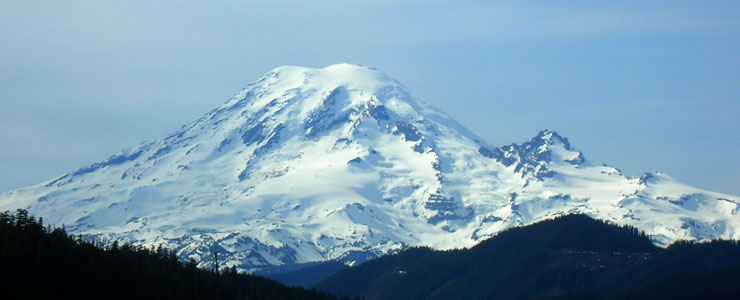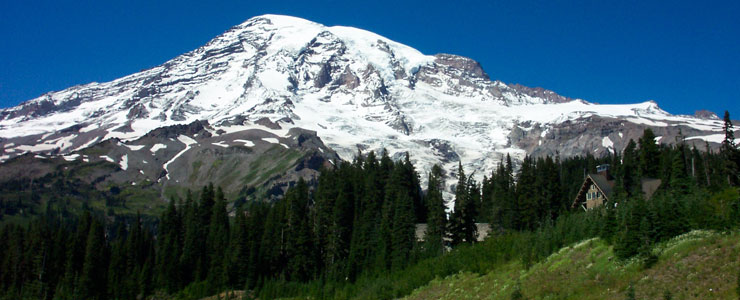Mount Rainier National Park

Mount Rainier from the White Pass Scenic Byway

Snow Lake
Mount Rainier National Park is a 236,381-acre property in central Washington. The heart of the park is Mount Rainier, a 14,410-foot stratovolcano that rises abruptly from the surrounding countryside. The peak is the highest point in the Cascade Range and is surrounded by old growth forest, waterfalls, valleys, wildflower-strewn subalpine meadows and more than 25 glaciers. That abrupt rise in elevation and the presence of all those glaciers make Mount Rainier a big target for mountain climbers every year but of the average 10,000 attempted climbs per year, only about half make the summit.
On average, the park sees more than one million visitors per year. Visitation is highest in July and August when the weather is warm and dry and the wildflowers in bloom... so if you're going in mid-summer, you might want to go during the week. Winter access to the park is limited to the Nisqually Entrance in the southwest corner of the park. The Carbon River entrance is usually open but within the park boundary, use is limited to foot and bicycles.
About 97% of Mount Rainier National Park is preserved as Mount Rainier Wilderness. Abutting the park boundary are the Tatoosh, Clearwater, Glacier View and William O. Douglas Wilderness Areas. Okanogan-Wenatchee National Forest is to the east and north, Mount Baker-Snoqualmie National Forest to the north and west and Gifford Pinchot National Forest to the south.
Mount Rainier National Park was established when President William McKinley signed the legislation creating America's fifth national park on March 2, 1899. The land had been set aside as the Pacific Forest Reserve in 1893. Then the reserve was enlarged and renamed the Mount Rainier Forest Reserve in 1897. Congress finally passed a bill authorizing the creation of the national park after it received assurances that none of the land involved was suitable for farming, there were no commercial quantities of valuable minerals hidden on the property and that the federal government would have to spend no money in managing the park.
Prior to the arrival of the Anglo-Americans, the Mount Rainier area had been used by several Native American tribes in the area primarily for summer hunting and gathering activities. Some also used the area for spirit quests but no one set up camp and stayed in the area year-round. The time of most Native American activity seems to be 4,500 to 8,000 years ago as evidenced by projectile points found along the Bench Lake Trail. A rock shelter was found near Fryingpan Creek that dates usage to between 1,000 and 300 years ago.
With 42 sites listed on the National Register of Historic Places, the whole of Mount Rainier National Park has also been designated a National Historic Landmark District. Most visited of all the areas of interest in the park is the Paradise area, home of the Paradise Inn and the Henry M. Jackson Visitor Center. Almost two-thirds of all visitors to Mount Rainier every year go to Paradise. Paradise is located at about 4,500 feet elevation on the south slopes of Mount Rainier. That location makes the site one of the snowiest places on Planet Earth with up to 1,000 inches of snow falling per winter being a regular phenomenon. On March 10, 1956, snow depth at Paradise was measured at 367 inches, a record for snow pile-up in the Cascades.
The second most visited place on Mount Rainier National Park is the Longmire Visitor Center, about 6.5 miles into the park from the Nisqually Entrance. Longmire is also the site of the Mount Rainier National Park Inn, the Longmire Museum and the 1928 National Park Service Administration Building (which is now a wilderness information center). The National Park Inn offers the only year-round accommodation on Mount Rainier National Park. About 2 miles northwest of Longmire is the Cougar Rock Campground with 173 individual campsites and 5 group campsites. Cougar Rock is generally open from late May through late September. About one-third of all visitors to Mount Rainier visit the Longmire area.

Mount Rainier is circumnavigated by the Wonderland Trail, a 93-mile route that accumulates some 22,000 feet in elevation gain along the way. Several thousand people hike sections of the trail every year but only a couple hundred or so make the entire route. Average time to complete the trail: 10 to 14 days. The route is classed as strenuous as it is nearly always climbing or descending the volcanic ridges that descend from the mountain. There are many river crossings along the route, many of those crossings being built only of piles of logs that tend to be washed away in times of high snowmelt. Because of the high snowfall on the upper slopes of the park, the Wonderland Trail is often snow-covered into early July. Some of the more popular alternative sections of the trail often see snow cover into late August. Best hiking season is late summer but snow can fall any time of the year. There are eighteen trailside camps spread from 3 to 7 miles apart along the route. Each camp has 1 to 8 sites that allow one to five people per site. As none of the sites is big enough to hold more than 2 tents, there are several group sites along the route, too. Each camping area has a pit or composting toilet, a bear pole for hanging food, cleared tent sites and a nearby water source. Hiking the trail requires a backcountry permit and reservations for the designated camping areas along the route. As popular as the Wonderland Trail is, there are hundreds of miles of other trails in the park, too.
Due to budget cuts forced by Congressional gridlock in 2013, many services were cut completely and some visitor centers and campgrounds did not open (and won't open again for the foreseeable future). Most other services were cut sharply or closed early for the season. Because of that, the park seems to be generally open from late May (in lower elevations) to early September at best. Some of the campgrounds are scheduled to be open until late September but that could change with a single good snowfall. The Longmire and White River wilderness and climbing information centers are generally open into mid-October.
Should you intend to climb above 10,000 feet or on any of the 25 glaciers within Mount Rainier National Park, you'll need a climbing pass. For folks 25 years of age or older, that pass will cost $44 per person. Under 25 the pass costs $31 per person. Day hikers in the wilderness need no permits but if you intend to camp overnight, you'll need a permit. Permits are available at any open wilderness information center, visitor center or ranger station in the park.
I was in the Mount Rainier area in early May, 2013, driving the White Pass Scenic Byway to the south. The top photo on this page is from that trip. As you can see, snow blanketed the mountain and the southern entrances to the park were still closed. Snow level at that time was around 6,000 feet... although the White Pass Ski Area was already closed for the season.

Mount Rainier from the Paradise area
Upper left photo courtesy of Steve Schmorleitz, CCA-by-SA 3.0 License
Photo taken from Paradise courtesy of Jim Heaphy, CCA-by-SA 3.0 License
Other photos courtesy of the National Park Service